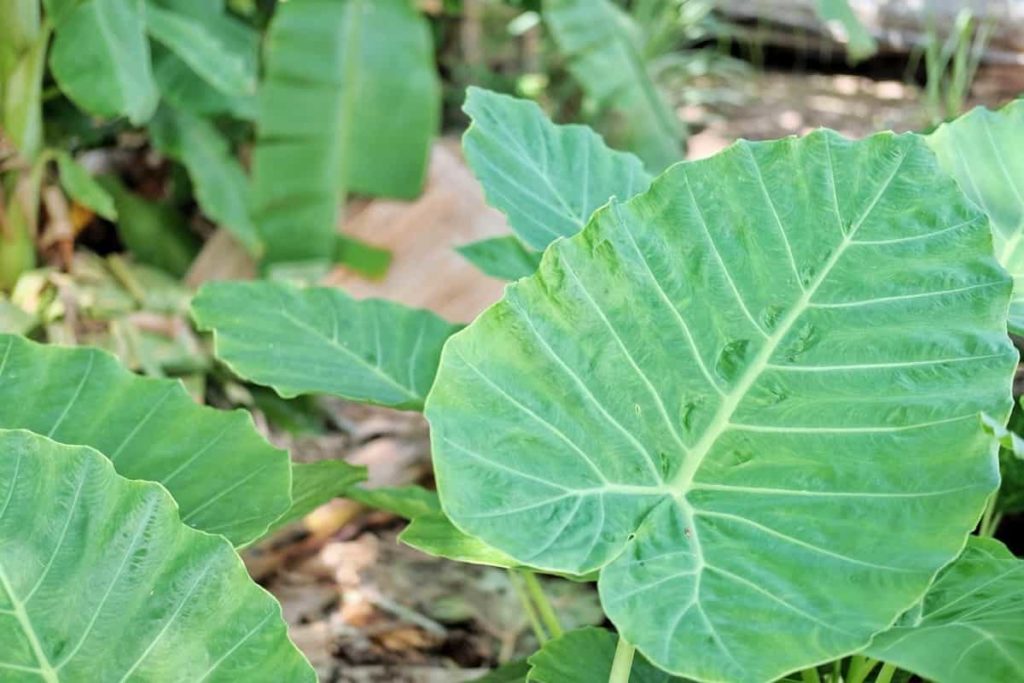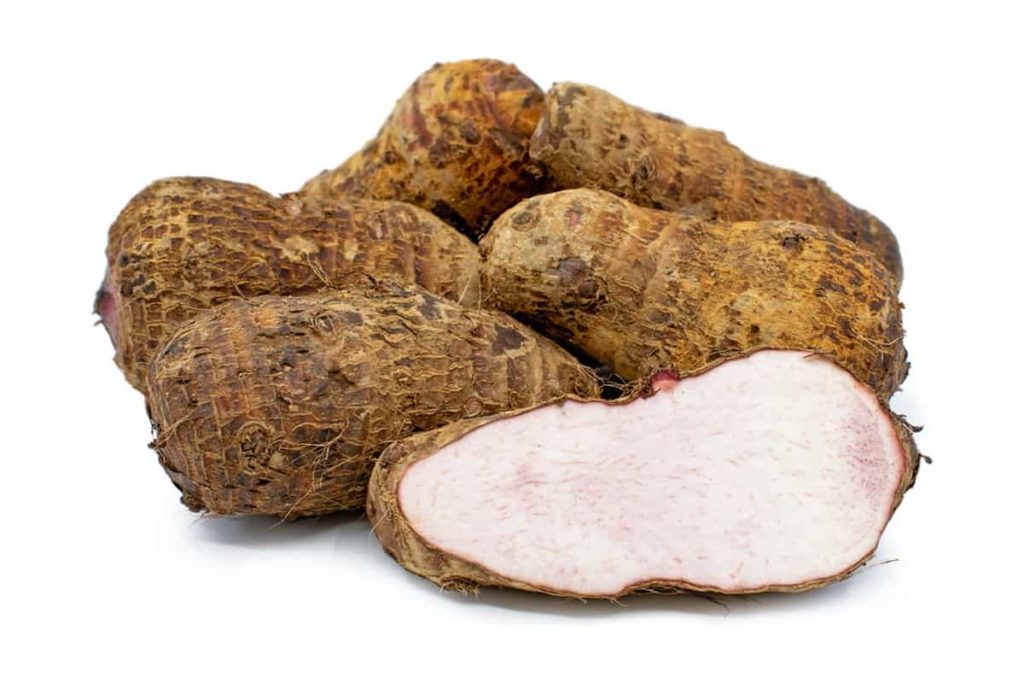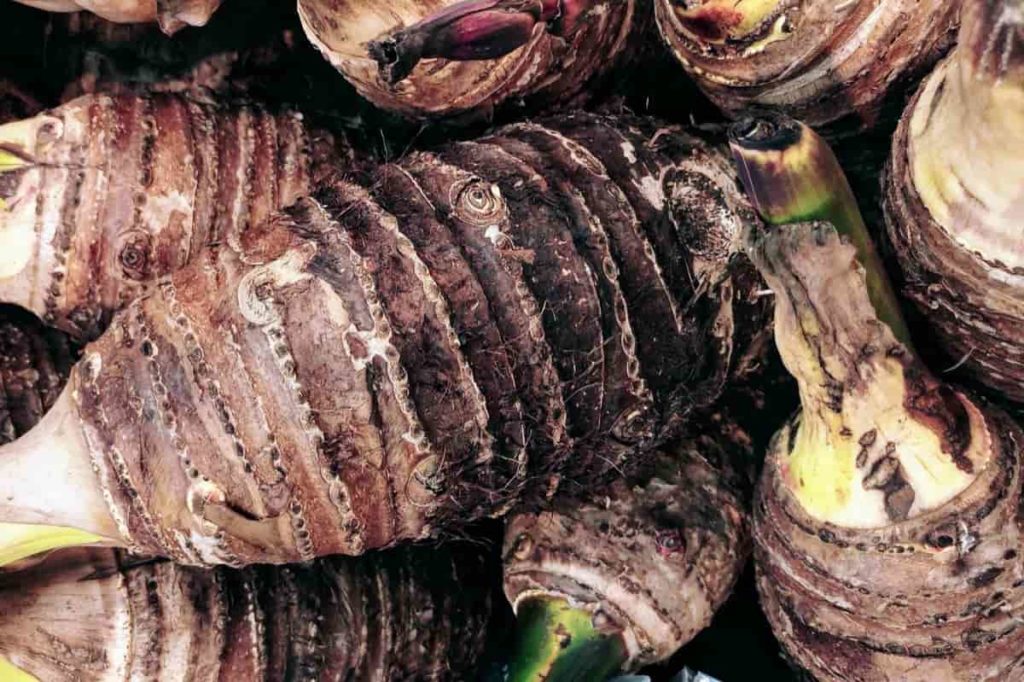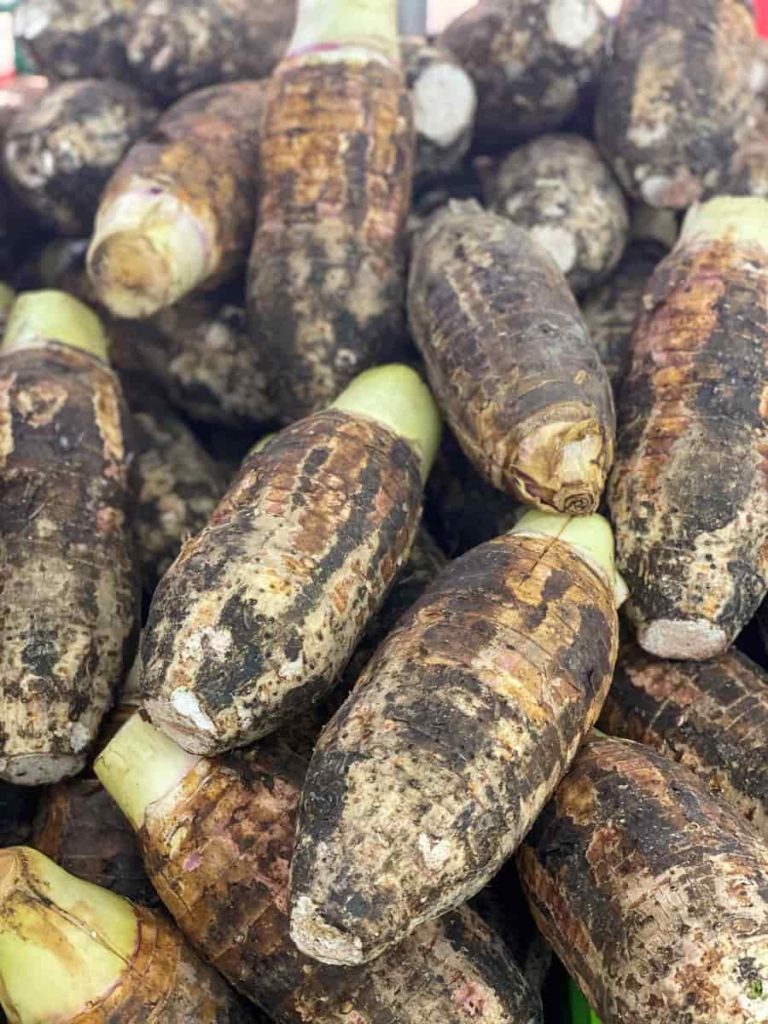Taro plants scientifically called Colocasia esculenta (L.) Schott is a tuber similar to a potato. It is a starchy root plant originating from Southeast Asia. Popularly used in dishes like Hawaiian poi, it is used in some of the famous words in the world. However, Taro is not just an edible food; the taro plant leaves resemble the gigantic ears of elephants, which is why the plant is used for home decorations. Known for its sour taste, Taro is widely consumed in India and other parts of Asia. Let’s check out the best practices to grow Taro Root at home below.

Taro is a perennial plant in the tropical region, believed to be one of the world’s oldest crops. Taro is an amazing source of dietary fiber and decent amounts of carbohydrates and enzymes, which improve the digestive system’s functioning, aiding healthy weight loss without side effects. Not just those, Taro is also rich in vitamin C, vitamin E, and vitamin B6, which add significant strength to the immune system. After the pandemic hit the world, people realized the need to eat clean and organic food on a large scale.
One can best ensure the product is grown organic by growing the plant themselves. Even before the pandemic, many people have had the habit of farming various varieties at home, like eggplants, Okra, etc. Given the health benefits of Taro along with the taste, people on a large scale grow Taro at home either in plants or in the backyard. Since Taro is perennial and has an excellent domestic market, it is also produced as a commercial crop. Below are some of the common questions about farming Taro at home.
Best practices to grow Taro Root at home
How can I grow the Taro plant at home?
- Taro can be grown at home in pots, containers, backyards, or on farms. They grow best when cultivated in greenhouses but can also yield when grown in low temperatures. They grow in temperatures as low as 10 degrees and produce best when grown between 25-35 degrees Celcius.
- The soil used for cultivation indoors or outdoors must be rich in nutrients and manure. The manure must be organic with no fertilizers involved. Using potash can be additionally beneficial.
- It takes almost 40-50 weeks for a taro plant to grow to its full potential and yield taro roots in the healthiest form. Taro roots are harvested only when the gigantic leaves of the taro plant start to turn yellow and slowly wither.
In case you missed it: Common Dairy Cattle Diseases, Symptoms, and Treatment: Check How this Guide Helps Dairy Farmers

How long do Taro Roots take to grow?
- Taro plant takes almost 35-40 weeks to grow big and healthy. Only after the plant grows big are the roots expected to grow big and juicy, healthy enough to consume.
- Usually, a taro plant takes 9-12 months to develop fully grown taro roots. After that, the plant leaves slowly turn yellow, eventually drying off and withering. This indicates that the roots have developed to their best, and it is time for harvest.
- This duration can be greater or lower according to the geographic location, climatic conditions, rainfall frequency, and also depending upon the care given to the plant.
- Suppose proper care is not taken regarding soil fertility. In that case, the manure used, the quality of seeds planted, watering of plant, and other essential aspects, one cannot expect the plant to yield soon, or even the yield itself is questionable.
Which is the best month to grow Taro Roots?
- Taro is a sub-tropical plant and prefers humid surroundings with a temperature range of 20-30 degrees. This indicates that Taro can be planted anytime, provided the conditions are maintained right with adequate nurturing.
- Even then, Taro yields best when planted at the end of winter in the Indian region and the onset of spring in foreign countries. This is because the following days would be frost-free, and temperatures would suit the plant to thrive and yield to the total capacity.
- This can ensure that all the contributing factors essential for the plant to grow to its healthiest are taken care of. However, any negligence regarding the nurturing of the plant would affect the yield; hence, the month of planting is to be chosen according to the expected temperature in the following 9-11 months, during which taro plants mature and yield healthy taro roots.
How many Taro Roots can one acre produce?
- Taro produces a yield close to 10 tons per acre with available produce of roots weighing between 2.5-3 kgs per plant. This is normal for a fully nurtured, healthy plant.
- This yield can be obtained after 9-10 months when the plant grows fully.
What is the lifespan of the Taro plant?
- The Taro plant shows roots growing up when the leaves start to yellow and eventually wither off.
- While harvesting taro roots follows this, the plant’s lifespan also ends with taro roots’ harvesting time.
- Even then, this count varies from locations across the globe, ranging averagely –between 7-12 months.
In case you missed it: Best Practices to Grow Sweet Potatoes at Home: Check How this Guide Helps Beginners

Does the Taro plant need full sun?
- Yes, taro plants need full sun for at least 6 hours a day, as the plant is a tropical and sub-tropical variety. However, this can range between 4 and 8 hours, depending on the season.
- In summers, as the temperature is mostly humid and hot, the sun exposure will be sufficient even for a less duration, whereas in winters, when the temperatures are cold, the sun time for a taro plant can be as long as 8 hours too.
- Sunlight is primarily for photosynthesis as the primary and only form of survival for the plant is photosynthesis.
How much water does the Taro plant need?
- Taro plants require moderate quantities of water, ranging from at least 1.5-2 inches above the soil to a maximum of 4 inches, depending upon the season and the subsequent climatic conditions.
- The taro roots absorb most of the water left other than the water used to retain soil fertility and productivity.
- Since Taro is a tuber with high starch content, it is obvious that more water is required for the plant to yield better roots and thrive long.
How can we increase the yield of Taro Roots?
- Taro yields best when only natural manure is used, and artificial fertilizers are avoided. To avoid poor and dry soil, the soil must be tested for quality and productivity.
- Manure mixed with appropriate potash proportions gives the plant the best yield. Along with this factor, other contributing elements, like watering, sun exposure, etc., must be taken care of to achieve the best results.
In case you missed it: Common Poultry/Chicken Diseases, Symptoms, and Treatment: Check How this Guide Helps Poultry Farmers
What type of soil is best for Taro Roots?
- Taro grows best in soil naturally rich in nutrients like phosphorous, nourishing plant growth. The soil used is tested before the planting of the crop to check quality and productivity. The best soil kind is sandy loam soil with good water draining capability.
- Soil is placed so that the water provided to either soil beds or into the pots is drained after a sufficient amount of water is used. Loam soil has excellent water retention and draining ability.
- The pH of the soil should be very slightly acidic or neutral, ranging between 5.5 to 7. More acidic soil would be fatal to the seed or seedling; the plant would not thrive if it is essential.
Can we grow Taro plants in pots?
- Yes, taro plants can be very well cultivated in pots. Taro is more feasible to produce in pots than on farms because pots do not retain much water from the soil and are easy to maintain.
- The height of a taro plant is short, which is more suitable to be grown in pots than on open farms. The pot dimensions need to be around 7-10 inches wide with a depth of 4-6 inches for the roots to grow full and long.
Can the Taro plant get too much sun?
- Taro cannot get too much sun because the leaves of the plant start to yellow while the roots are harvested, which fails to be observed due to the premature yellowing of plant leaves due to excess sunlight.
- The ideal time of sun exposure for a taro plant is 4-8 hours per day, which again changes with changing geographical
In case you missed it: Common Goat Diseases, Symptoms, and Treatment: Check How this Guide Helps Goat Farmers

How long does it take for a Taro plant to grow taro roots?
- A taro plant grows to its maximum height in a duration of 10 months. After this duration, the taro plant can be seen yellowing along the leaves, indicating the roots have stopped absorbing water due to the grown-up taro roots.
- After around 12 weeks, the taro roots would be fully grown and ready to be harvested. This can be done by digging the soil around the plant to a depth of 4-6 inches depending upon the method of harvesting employed.
Is Taro healthier than potato?
- Yes, Taro is considered to be healthier than potatoes in some aspects. However, the health benefits taro offers are higher than those of potatoes, and importantly, the vitamin richness of Taro is by and large greater than potato.
- Taro also contains comparatively less starch which can be adequate without overdosing on carbohydrates when consumed.
What is the fastest way to germinate Taro seeds?
- The best way to germinate taro seeds is by using the priming technique. It is the process of regularly placing the seeds in rich soil, added with natural manure and compost, and watering the seeds with adequate amounts of water. This is done for 24 hours.
- This process initiates the seed germination within the seed even before planting it in the soil and thus helps faster germination of seedlings than usual.
What is the procedure to grow Taro roots at home?
- Taro roots are produced from the taro plant, where the roots grow inside the soil as tubers. This is similar to the production of potatoes and another tuber family.
- The first step is deciding on where to grow the taro plant. This is important to reduce costs and unwanted expenditures. In most cases, it is cultivated in pots, but farms are preferred when intended to produce on a large scale.
- The soil should be selected so that the water retention and draining capability of the soil must be equally reasonable to avoid seed overdosing on water or dying due to poor water supply. Sandy loam soil is best suitable for the requirements.
- The seeds must be bought from a trusted vendor and planted into the soil to a depth of 4 inches with a spacing of 9-12 inches between seed to seed. The gap between seed rows is around 2 feet for the roots to grow adequately and spread under the soil freely.
- After the planting, regular watering is done to a height of 2 inches above the soil level and ensures that the water is neither overdosed nor lower than average.
- Sunlight can be allowed onto the plant for a maximum of 8 hours, so the plant is not too dried up before harvesting.
- After a duration of 10 weeks, the roots start to develop into fully healthy taro roots. This is visible from the yellowing of leaves; one can harvest after 12 weeks.
In case you missed it: How to Grow Curry Leaf/Kadipatta Plant at Home: Check How this Guide Helps Beginners

Conclusion
Taro is a tuber similar to the potato but is uniquely recognized for its sour and sweet flavor. In addition, the roots offer many health benefits that other tubers lack. The richness in fiber content, vitamins, and the fact that they can grow only in natural manure-boosted soil makes Taro such healthy edible food. These are some of the common queries regarding farming taro roots at home.
- Sheep Farming Business Plan for Beginners
- Aquaponic Farming at Home: A Step-By-Step Guide
- Profitable Village Farming Business Ideas in 2024
- High-Yield Aquaculture: Fast-Growing Fish for Farming
- Effective Fish Pond Construction Techniques for Beginners
- Irrigation and Water Management in Pineapple Farming
- Blossom to Harvest: Mastering Flowering and Pollination in Papaya Farming
- Pig Fattening Essentials: From Selection to Sale for Beginners
- Raising Wagyu Cattle: A Complete Guide for Premium Beef Production
- Soil Types and Their Water Holding Capacity
- Optimizing Irrigation Schedules for Coconut Groves for Enhanced Yield
- Espresso Your Garden: Coffee Grounds for Healthier Acid-Loving Plants
- The Best Soil Mix for Snake Plants: How to Mix Your Own Snake Plant Soil
- Green Thumb Success: Expert Tips for Cultivating Greenhouse Beans All Year Round
- Bloom All Year Round: The Ultimate Guide to Indoor Hyacinth Care
- Eco-Friendly Gardening: How to Make Liquid Fertilizer from Kitchen Waste
- Ultimate Guide to Grow Anise in Pots: Explore Seed Propagation to Harvesting
- Guide to Raising Chester White Pigs: Discover Breed Facts to Growth Management
- Mastering the Elegance: The Ultimate Guide to Weeping Cherry Tree Care, Planting, and Maintenance
- Ultimate Guide to Planting Garlic in Grow Bags: Growing Strategies for Beginners
- How to Fix Spider Plant Leaf-Related Problems: Natural and Organic Remedies
- 10 Reasons Why Your Tulsi Plant is Shedding Leaves: Home Remedies and Solutions
- Optimizing Growth and Yield: The Advantages of Palm Bunch Ash Fertilizer
- Utilizing Neem Oil Extract as a Natural Pesticide for Hydrangea
- From Soil to Harvest: Various Ways in Which Farmers Can Use AI Tools
- Steps to Encourage and Induce Citrus Flowers: A Comprehensive Guide
- How to Fix Snake Plant Leaf-Related Issues: Natural and Organic Remedies
- Transform Your Garden into a Fragrant Oasis with Raat Ki Rani (Night Blooming Jasmine)
- Discover the Ideal Chicken Breeds for Philippine Farms
- How to Create a Poultry Egg Farm Business Plan for Profits
- Grow Lemon Cucumbers Like a Pro: Insider Techniques for Bountiful Yields
- Ultimate Guide to Caring for Your Pink Princess Philodendron: Tips for Thriving Variegation
- Areca Nut Profit Per Acre: Calculating Yield and Cost of Cultivation
- How Kaveri Chicken is Becoming a More Profitable Breed in Indian Backyards
- Transform Your Barn: 9 Steps to Convert a Horse Stall into a Chicken Coop
- Exploring Suffolk Sheep Disadvantages with Limitations and Challenges

